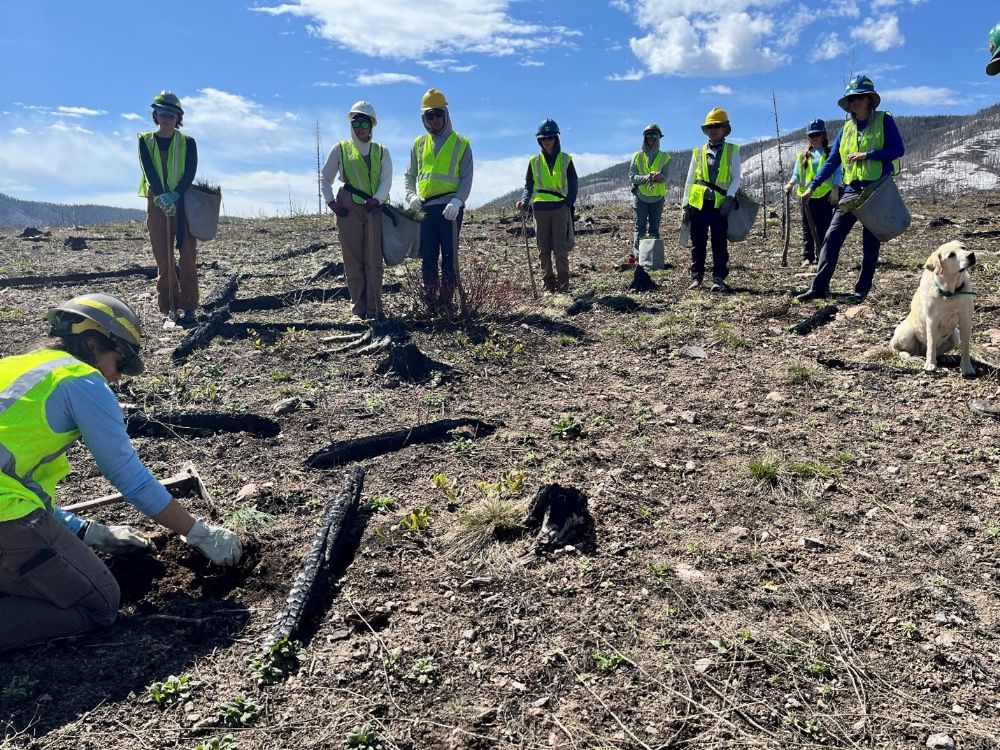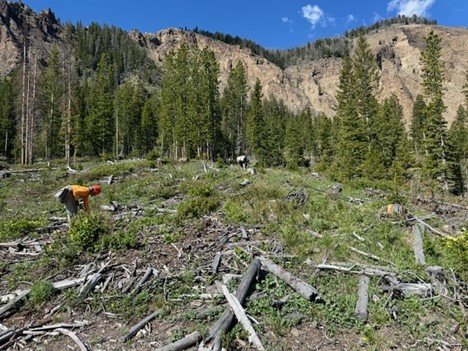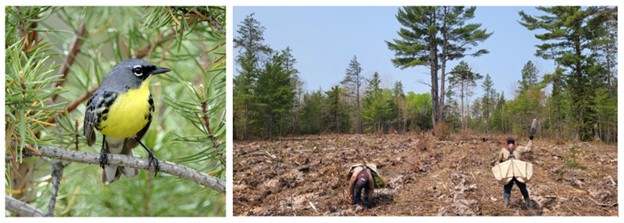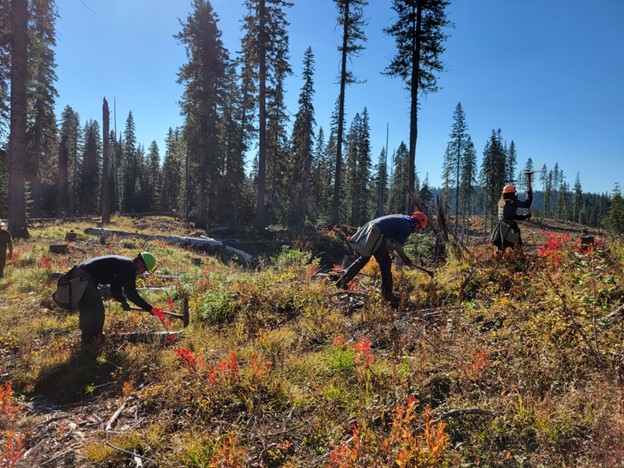Your Impact
Project summaries for your donations to “where it’s needed most” are shared here. These donations are received by the national office over the course of the year and are distributed to various locations in the national forest system to be used the following year.
Timeline example: Donations are received in 2022, used for projects implemented in 2023, and reports are available in 2024 after the project is complete. The Federal Government Fiscal Year is October 1-September 30.
Donations that are made directly to a national forest are not reported here. Those donations are managed by the national forest and will be utilized when there is a reforestation need there and when enough donations can be pooled to put towards a project. There may not be a need or enough funds available to implement projects every year.
Fiscal Year 2024

The Yampa Valley Sustainability Council planting event on the Silver Creek Fire Reforestation Project on the Medicine Bow-Routt National Forest in Colorado. (USDA Forest Service Photo)
Project Name & ID Number: Silver Creek Fire Reforestation Project
Location: Medicine Bow-Routt National Forest, Colorado
Tree Species: Lodgepole Pine
Area Reforested: 105.3 acres / 53,300 seedlings
Implementation Date: June 2024
Plant-A-Tree Donations: $ 43,500
Summary: In 2018, a lightning strike in the Sarvis Creek Wilderness started the Silver Creek Fire that spread to over 20,000 acres, including Forest Service land outside of the wilderness boundary. The fire burned intensely in lodgepole pine and spruce fir forests, which had been experiencing increased mortality due to a beetle infestation. This caused heavy losses to the pine seedlings that had been regenerating beneath the dry, standing dead trees.
Over the past few years, with help from The Yampa Valley Sustainability Council (YVSC), the silviculture team on the Yampa and Hahns Peak Bears Ears Ranger Districts conducted regeneration surveys and determined an estimated 1,500 acres required replanting. In June of 2024, the districts carried out two planting events: one through a contracted planting crew, and the second with YVSC volunteers. In subsequent years, and as capacity is increased, annual planting seedling numbers will also increase, helping to reestablish a healthy forest.

Crew Planting trees in the Stonewall Insect and Desease Response Reforestation 2024 project in Shoshone National Forest, WY. (USDA Forest Service photo)
Project Name & ID Number: Stonewall Insect and Disease Response Reforestation 2024
Location: Shoshone National Forest, WY
Tree Species: Engelmann Spruce and Douglas Fir
Area Reforested: 105 acres / 21,768 seedlings
Implementation Date: June 2024
Plant-A-Tree Donations: $ 23,380
Summary: Over the last few years, the Shoshone National Forest has experienced multiple periods of Mountain Pine beetle, Spruce Budworm, and Dwarf Mistletoe infestation. Tree mortality in some areas was upwards of 60-80% of the stand, leaving little to no seed sources surviving to grow into the new forest.
In June 21,768 seedlings were planted on the Greybull Ranger District over the course of two days. These areas were identified for planting to promote future forest vegetation and reduce the risk of widespread insect and disease-caused tree mortality. These locations hold a high value for aesthetics, future forest products, watershed function, wildlife habitat, and recreation opportunities.
.
Fiscal Year 2023

Left: Kirtland’s Warbler (USDA Forest Service photo) Right: Contract workers planting trees in the 2023 West Zone Pine Planting reforestation project in Hiawatha National Forest, Michigan (USDA Forest Service photo)
Project Name & ID Number: West Zone Pine Planting Project #0910-FY2023-20
Location: Hiawatha National Forest, Michigan
Tree Species: Jack Pine and Red Pine
Area Reforested: 112 acres / 80,000 seedlings
Implementation Date: May 22-31, 2023
Plant-A-Tree Donations: $ 18,400
Summary: This planting project enhanced and created the habitat needed for Kirtland’s Warbler and other species that depend upon healthy young pine stands to proliferate. After nearly 50 years on the Endangered Species List, successful active management to create Kirtland's Warbler habitat allowed populations to recover and the species to be delisted in 2019. The Kirtland’s Warbler is known as a habitat specialist, which means that it will only nest in a very specific area or in specific conditions. More than 90% of Kirtland's Warblers' nests are in one small area of northern Michigan, some 70 miles from north to south and 90 miles from east to west. The combination of low-hanging, overlapping branches of young jack pines with sandy, well-draining soil that rarely floods is perfect for a bird that nests on the ground. Creation of these young stands is achieved through harvest and planting of jack pine and red pine seedlings, or naturally through fire.

Contract workers planting trees in the 2023 Lower Orogrande Stewardship reforestation project in Nez Perce-Clearwater National Forest, Idaho (USDA Forest Service photo)
Project Name & ID Number: Lower Orogrande Stewardship Project #0117-FY2023-37
Location: Nez Perce-Clearwater National Forest, Idaho
Tree Species: Western Larch, Western White Pine, and Ponderosa Pine
Area Reforested: 127 acres / 52,482 seedlings
Implementation Date: October 9-13, 2023
Plant-A-Tree Donations: $ 26,084
Summary: The goal of this project was to plant long-lived seral species that are more resistant to root disease infections and insects, and that are also more fire tolerant. This project occurred near the wildland urban interface of Pierce, Idaho, further increasing the need for fire resilient stands. This project improved tree species diversity and balanced vegetative successional stages across the landscape toward conditions within the historic range of variability, allowing for a more rapid recovery from future forest disturbances.
